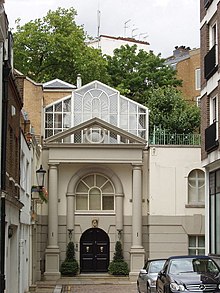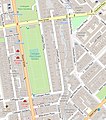
Cadogan Lane, originally Little Cadogan Place, is a street in London's Belgravia which runs between Pont Street in the north, and a junction with Cadogan Place and D'Oyley Street in the south. It is one of the streets in the area named after the Earls of Cadogan that began to be developed in 1777. The lane was laid-out by 1799 but had few buildings until the twentieth century. Today it is mostly made up of small mews houses which back onto the larger houses in Cadogan Place, and Chesham Place and Chesham Street, between which Cadogan Lane runs.
Origins
Cadogan Lane is one of the streets in the area named after the Earls of Cadogan whose ancestor Hans Sloane purchased the Manor of Chelsea in 1712. [1] [2] Development of the area began in 1777 [3] with the street laid-out by 1799 when it was shown as Little Cadogan Place on Richard Horwood's map of that year. [4] It was still marked by that name on George Bacon's map of 1888. [5]
-
Little Cadogan Place (right) on Richard Horwood's map of 1799
-
Little Cadogan Place on George Bacon's map of 1888
-
Second World War bomb damage map (Black = total destruction. Purple = damaged beyond repair. Other colours = lower levels of damage.) [6]
-
Modern area map
Twentieth century

Cadogan Lane had few buildings until the twentieth century, being mainly the back gardens, stables, and servants' quarters of the large houses that fronted Cadogan Place, such as the home of the Macmillan family, [7] and the rear of the houses in Chesham Place and Chesham Street. As late as the 1950s, houses might have front entrances on the more prestigious Cadogan Place and back entrances in the more modest Cadogan Lane, such as number 39 where future High Court judge Ronald Waterhouse lived as a student. [8]
Second World War period
Cadogan Lane was hit by several German bombs during the Second World War. [6] Among the properties damaged was the Cadogan Riding School in Cadogan Lane, one of the largest schools in London, which had 260 horses and ponies, [9] and the studio of art collector Tommy de Walden (8th Baron Howard de Walden) which was hit by enemy bombs twice during the war. [10]
1960s onwards
In the 1960s, a flat in Cadogan Lane became a centre for experiments in LSD use. Drug evangelist Michael Hollingshead visited [11] and Joey Mellen described it as "one of the happiest turn-on centres there's ever been". [12]: 102 Hollingshead described it as "Lots of young people on acid, eating sugar, with no one putting over a big mystery scene". [12]: 103
Judy Garland died in June 1969 at 4 Cadogan Lane, [13] [14] north of Pont Street. She was found by her husband Mickey Deans, sitting on the toilet having accidentally overdosed on barbiturates. [14] After being empty for many years, the house was due to be demolished in 2014, and a new one built in its stead [14] [15] but it was not demolished until 2019. [16] A campaign for English Heritage to erect a blue plaque failed as the house's owners did not give their consent. [16]
In the early 1970s, Bruce Fogle worked at Woodrow & Singleton Veterinary Surgeons on the corner of Cadogan Lane and Pont Street. [17]
References
- ^ Ehrlich, Blake. (1968) London on the Thames. London: Cassell. p. 347.
- ^ Bebbington, Gillian. (1972) London Street Names. London: B.T. Batsford. p. 67. ISBN 0713401400
- ^ Denny, Barbara. (1996) Chelsea Past. London: Historical Publications. p. 117. ISBN 9780948667398
- ^ Laxton, Paul & Joseph Wisdom. (1985) The A to Z of Regency London. London: London Topographical Society. p. 43. ISBN 0902087193
- ^ Hyde, Ralph. (1987) The A to Z of Victorian London. London: London Topographical Society. p. 45. ISBN 090208724X
- ^ a b Ward, Laurence. (2015) The London County Council Bomb Damage Maps 1939–1945. London: Thames & Hudson. p. 110. ISBN 9780500518250
- ^ Davenport-Hines, Richard. (1992) The Macmillans. London: Heinemann. ISBN 9780434175024
- ^ Waterhouse, Ronald. (2013) Child of Another Century: Recollections of a High Court judge. London: Radcliffe Press. p. 59. ISBN 9781780764993
- ^ Munkwitz, Erica. (2021) Women, Horse Sports and Liberation: Equestrianism and Britain from the 18th to the 20th Centuries. Abingdon: Routledge. ISBN 9780367209506
- ^ Preston, Paul. (2002) Doves of War: Four women of Spain. London: HarperCollins. pp. 95, 110, 111. ISBN 9781555535605
- ^ Roberts, Andy. (2019) Divine Rascal: On the Trail of LSD's Cosmic Courier, Michael Hollingshead. London: Strange Attractor Press. p. 118. ISBN 9781907222788
- ^ a b Roberts, Andy. (2008) Albion Dreaming: A popular history of LSD in Britain. Revised edition. London: Marshall Cavendish. ISBN 9789814328975
- ^ Baker, Rob (2017). High Buildings, Low Morals: Another Sideways Look at Twentieth Century London. Stroud, Gloucestershire: Amberley Publishing Limited. p. 265. ISBN 978-1-4456-6625-9.
- ^ a b c Tomrley, Corinna (4 March 2014). "4 Cadogan Lane: The house that Judy died in". Civilian. Retrieved 21 September 2021.
- ^ "Mews evolution won't stop ... not even for celebrities". Lurot Brand. Retrieved 21 September 2021.
- ^ a b Singh, Anita (6 August 2019). "Judy Garland to be denied blue plaque as London home falls victim to the wrecker's ball". Daily Telegraph. Retrieved 21 September 2021.
- ^ Fogle, Bruce (2020). "1.". Call the Vet: My life as a young vet in 1970s London. Harper Collins. ISBN 978-0-00-842433-6.
External links
-
 Media related to
Cadogan Lane, London SW1 at Wikimedia Commons
Media related to
Cadogan Lane, London SW1 at Wikimedia Commons


![Second World War bomb damage map (Black = total destruction. Purple = damaged beyond repair. Other colours = lower levels of damage.)[6]](https://upload.wikimedia.org/wikipedia/commons/thumb/d/d1/Second_World_War_bomb_damage_map_Cadogan_Place_area.jpg/90px-Second_World_War_bomb_damage_map_Cadogan_Place_area.jpg)


